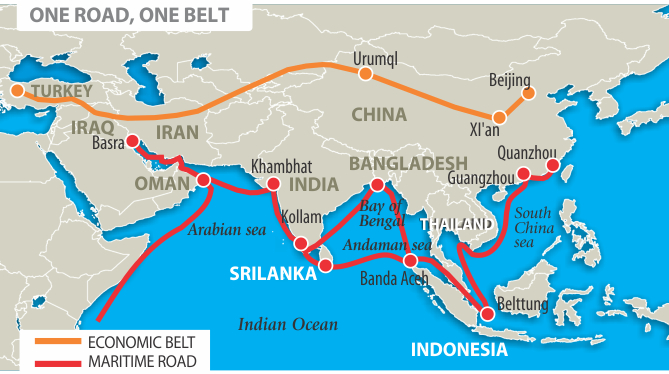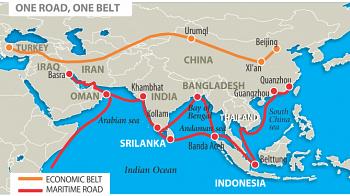China’s New Silk Road project: Focus on South Asia
Part -1: Rising Chinese power
China, the only veto power of Asia and major global power, is seen trying to take a larger role in global affairs by promoting its economic ventures across continents of Asia, Africa and Europe by joint efforts. Obviously, besides making joint ventures with wiling partners, China may be trying to put an end to US monopoly in world affairs, Beijing would like to share domination with USA.
China has come out with a fast forward idea of working together for greater benefits for all nations involved. The Silk Road Economic Belt and the 21st-century Maritime Silk Road or One Belt, One Road (OBOR) is a development strategy, proposed by Chinese President Xi Jinping that focuses on connectivity and cooperation among countries primarily between the People's Republic of China and the rest of Eurasia, which consists of two main components, the land-based "Silk Road Economic Belt" (SREB) and oceangoing "Maritime Silk Road" (MSR).
The China Pakistan Economic Corridor (CPEC) and the Bangladesh-China-India-Myanmar (BCIM) Economic Corridor are officially classified as "closely related to the Belt and Road Initiative".
The strategy underlines China's push to take a bigger role in global affairs, and its need for priority capacity cooperation in collective economic affairs in areas such as steel manufacturing.
The One Belt One Road initiative is geographically structured along 6 corridors, and the maritime Silk Road. New Eurasian Land Bridge, running from Western China to Western Russia; China - Mongolia - Russia Corridor, running from Northern China to Eastern Russia; China - Central Asia - West Asia Corridor, running from Western China to Turkey; China - Indochina Peninsula Corridor, running from Southern China to Singapore; China - Pakistan Corridor, running from South-Western China to Pakistan; Bangladesh - China - India - Myanmar Corridor, running from Southern China to India; Maritime Silk Road, running from the Chinese Coast over Singapore and India to the Mediterranean.
Essentially, the 'Belt' includes countries situated on the original Silk Road through Central Asia, West Asia, the Middle East, and Europe. It goes through Central Asia, Russia to Europe.
One Belt, One Road has been contrasted with the two US-centric trading arrangements, the Trans-Pacific Partnership and the Transatlantic Trade and Investment Partnership.
The China-proposed Belt and Road Initiative offers enormous opportunities for all the countries involved and Greek business community warmly supports all the efforts to deepen the two countries' cooperation under this context, President of the Greek-Chinese Economic Council Fotis Provatas said recently.
OBOR Summit 2017
Chinese President Xi Jinping welcomed UN Secretary-General Antonio Guterres before the Leaders' Roundtable Summit at the Belt and Road Forum (BRF) for International Cooperation at Yanqi Lake International Convention Center in Beijing, capital of China, May 14-15, 2017. Around 30 state and government heads as well as delegates from more than 100 countries – including the USA and North Korea – discussed the Belt and Road initiative, one of the world’s biggest economic diplomacy programs led by China.
In a keynote speech delivered at the opening ceremony of the two day Initiative called Belt and Road Forum for International Cooperation held in Beijing on May 14 President Xi Jinping said that China would launch Belt and Road cooperation initiative on trade connectivity together with some 60 countries and international organizations. Xi said that the Belt and Road Initiative embodies the aspiration for inter-civilization exchanges, the yearning for peace and stability, the pursuit of common development and the shared dream for a better life. President Jinping called for renewing the Silk Road spirit. Noting that "we are at a fresh starting point, ready to embark on a new journey together," Xi said, "so long as we press ahead with a common vision without backpedaling or standing still, we will achieve greater connectivity and benefit from each other's development." Before the banquet, Xi and his wife Peng Liyuan greeted the guests at the Great Hall of the People.
Apart from this zone, which is largely analogous to the historical Silk Road, another area that is said to be included in the extension of this 'belt' is South Asia and Southeast Asia. Many of the countries that are part of this belt are also members of the China-led Asian Infrastructure Investment Bank (AIIB). North, central and south belts are proposed. The Central belt goes through Central Asia, West Asia to the Persian Gulf and the Mediterranean. The South belt starts from China to Southeast Asia, South Asia, to the Indian Ocean through Pakistan. The Chinese One Belt strategy will integrate with Central Asia through Kazakhstan's Nurly Zhol infrastructure program. The coverage area of the initiative, however, is primarily Asia and Europe, encompassing around 60 countries. Oceania and East Africa are also included.
The summit was aimed to map out China’s ambitious new Silk Road project, of which the OBOR is an integral part. The scheme was proposed in 2013 by Xi to promote a vision of expanding links between Asia, Africa and Europe. China has earmarked US$40 billion for a special fund for the scheme, on top of the US$100 billion capitalization for the China-led Asian Infrastructure Investment Bank, many of whose projects will likely be part of the initiative. The OBOR’s wingspan is expected to include 68 nations from China through Southeast and South Asia to Africa and Europe.
The UK’s Chancellor Philip Hammond described the UK as a “natural partner” for the Belt and Road Initiative, while Mexico’s Economy Minister Ildefonso Guajardo touted China as a possible alternative trading partner in the face of US protectionism
Italian PM Paolo Gentiloni has said that Italy and China had a lot to give each another in terms of tourism and cultural cooperation because they are both ancient civilizations "that strike the popular imagination." The year 2020 marks the 50th anniversary of diplomatic relations between Italy and China, a milestone target that could be a good objective to multiply cultural cooperation as well as tourism. Gentiloni said the culture ministries of both countries were working together on a number of projects, for example "the fact that Italy and China are the two countries in the world with the highest number of UNESCO World Heritage sites.”Ours are two civilizations that strike the popular imagination," he said, citing ancient Rome, the Renaissance, and the appeal of contemporary Italian culture, food, fashion, and design.
The conspicuous absence of the heads of state from the major Western economic powers and Japan at the belt and road summit this month in Beijing is a big mistake and a missed opportunity for enhancing dynamic and cooperative globalization. India, also seeking wide stage to promote its own interests, chose to ignore the China initiate.
Cost and Benefits
The initiative, unveiled in September 2013 by President Xi Jinping, aims to connect China by a network of overland corridors and sea routes to the rest of Asia, Africa and beyond, linking the dozens of countries through infrastructure and financial and trade ties. The economies along the routes account for about 63 per cent of the world’s population and 29 per cent of global GDP.
Comments
There are 0 comments on this post













